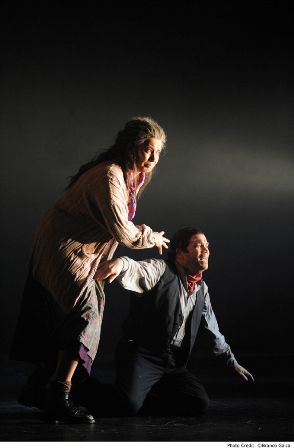
Built around a plot of such impenetrability that even Opera Australia has billed it as improbable, it is nevertheless filled with such dark and haunting music that it is judged one of the composer’s greatest works.
OA is right, it is one of those warhorse plots in opera, complete with frustrated love, revenge and a dangerous gypsy, yet it has always succeeded in a curious way, partly because of the psychological truths and certainly because of its music.
The opera is burdened by a major dramaturgical problem. From the very early scenes, it is quite clear to the audience that the young troubadour and, in this production, revolutionary hero, Manrico, is not the son of the gypsy Azucena, but in fact the brother of the obnoxious Count di Luna.
It might be going too far to evoke the example of Dostoevsky’s “Crime and Punishment”, but with such a spoiler, one could have expected the compensation of a subtle development of character in the two brothers. This never eventuates. Manrico is convincing enough as a heroic character, but Di Luna quite fails to account for his cruelty and insensitivity. What is it that doesn’t get about the love between Manrico and Leonora?

Without doubt the star of the evening is the dramatic mezzo-soprano Milijana Nikolic, lush-voiced and menacing as the Gypsy who brings the opera to its predictable close. One can only speculate on the dangerous qualities she will bring to the role of Carmen for this year’s Handa Opera.
Arnold Rawls as Manrico and Daria Masiero as Leonora more than make up for the words with the dramatic vocal rentions of the leading parts.
Though unable to bring psychological veracity to his thinly-written role, baritone Michael Honeyman as Count di Luna make his solo debut with a biting vocal rendition of a stage villain. There is the hint of a young Michael Lewis in his vocal presence.
Richard Anderson as the all-purpose clergyman sings with splendid clarity.
Oh, yes, and it must be said, the chorus of OA, surely its pride and joy, shines as brightly as any of the stars.
Nick Schlieper’s sculptural lighting gives us more darkness then light, effective, but oppressive at time, while Michael Scott Mitchell’s gloomy set, busy with niches and prison bars, effectively evokes the hate-ridden castle of Count di Luna.
There is nothing adventurous about the visual transition from the 15th century to the Spanish civil war era, but it does lead to some odd costumes by Judith Hoddinott, with at least two unflattering gowns for Leonora and some silly wedding outfits for the nuptials that never happen.
This “Trovatore,” though hard to believe, stirs the emotions.

Who can be trusted?
In a world of spin and confusion, there’s never been a more important time to support independent journalism in Canberra.
If you trust our work online and want to enforce the power of independent voices, I invite you to make a small contribution.
Every dollar of support is invested back into our journalism to help keep citynews.com.au strong and free.
Thank you,
Ian Meikle, editor




Leave a Reply